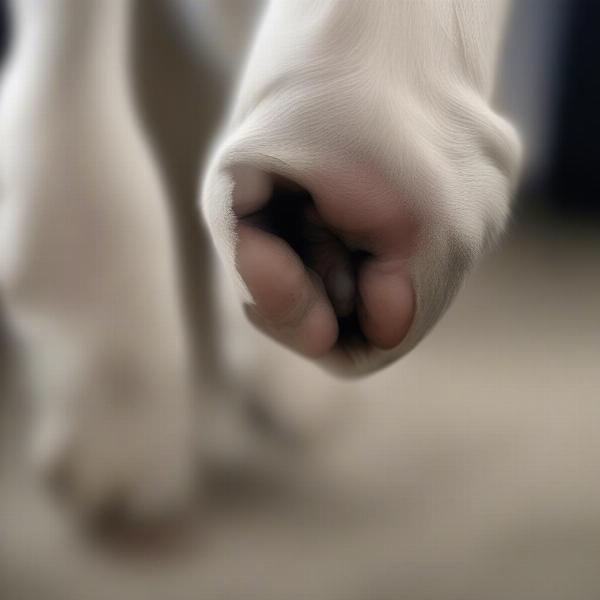A torn cruciate ligament in dogs is a common and painful injury. Understanding the causes, symptoms, diagnosis, and treatment options for dog cruciate ligament surgery is crucial for any dog owner. This guide provides a comprehensive overview of everything you need to know about this important topic, from pre-operative care to post-operative recovery.
Understanding Cruciate Ligament Injuries in Dogs
The cranial cruciate ligament (CCL), similar to the ACL in humans, stabilizes the knee joint. A rupture or tear of this ligament causes instability and pain, hindering your dog’s mobility. Several factors contribute to CCL injuries, including genetics, breed predisposition (e.g., Rottweilers, Labrador Retrievers), age, obesity, and repetitive stress. Recognizing the signs is the first step towards ensuring your dog receives the necessary care.
 Dog showing symptoms of a cruciate ligament tear
Dog showing symptoms of a cruciate ligament tear
Diagnosing a Cruciate Ligament Tear
If you suspect your dog has a CCL tear, consult a veterinarian immediately. They will perform a physical examination, checking for instability in the knee joint using specific maneuvers like the “cranial drawer test.” X-rays are also essential to confirm the diagnosis, rule out other conditions, and assess the extent of the damage. In some cases, advanced imaging like MRI may be recommended.
Dog Cruciate Ligament Surgery Options
Several surgical techniques are available to repair a torn CCL. The most common options include:
- Tibial Plateau Leveling Osteotomy (TPLO): This procedure changes the angle of the tibial plateau, eliminating the need for the CCL.
- Tibial Tuberosity Advancement (TTA): This technique advances the tibial tuberosity, altering the forces acting on the knee joint.
- Extracapsular Repair: This method involves placing a suture outside the joint capsule to stabilize the knee. cruciate surgery dog offers more insights into this procedure.
Your vet will recommend the most appropriate surgical option based on your dog’s breed, size, age, activity level, and the severity of the injury. Factors like cost and recovery time also play a role in the decision-making process.
Post-Operative Care and Recovery
After surgery, your dog will require strict rest and restricted activity for several weeks. Pain management is crucial, and your vet will prescribe medications to keep your dog comfortable. Physical therapy is an integral part of the recovery process, helping to restore strength, range of motion, and prevent muscle atrophy. Follow-up appointments with your vet are essential to monitor healing and adjust the rehabilitation plan as needed.
What to Expect After Dog Cruciate Ligament Surgery?
Many pet parents wonder what to anticipate after their dog undergoes this procedure. Expect a period of restricted activity and a gradual return to normal function. With proper care and rehabilitation, most dogs regain good mobility and enjoy a pain-free life. double knee brace for dogs might be recommended for added support during recovery. Don’t hesitate to reach out to your vet if you have any concerns.
Conclusion
Dog cruciate ligament surgery is a significant procedure, but it can dramatically improve your dog’s quality of life. By understanding the causes, symptoms, diagnosis, and treatment options, you can make informed decisions and provide the best possible care for your furry friend. dog tta surgery provides more specific information about the TTA procedure.
FAQ
- How much does cruciate ligament surgery cost for a dog? The cost can vary depending on the surgical technique and location, but it typically ranges from a few thousand dollars.
- What is the success rate of cruciate ligament surgery in dogs? The success rate is generally high, with most dogs regaining good mobility. tta surgery dog offers more specific statistics.
- How long is the recovery period after cruciate ligament surgery? Recovery typically takes several months, with gradual improvement over time.
- What are the signs of a torn cruciate ligament in a dog? Common signs include limping, stiffness, swelling, and difficulty bearing weight on the affected leg.
- Can a dog tear both cruciate ligaments? Yes, it is possible for a dog to tear both cruciate ligaments, often at different times.
- What is the best type of cruciate ligament surgery for dogs? The best type of surgery depends on individual factors like breed, size, and activity level. Your vet will recommend the most suitable option.
- What are the alternatives to cruciate ligament surgery for dogs? In some cases, conservative management with rest, medication, and bracing may be an option, especially for smaller dogs. tibia in dogs can offer a deeper understanding of the anatomy involved.
ILM Dog is your trusted source for expert advice on dog care, offering a range of resources on dog breeds, health, training, nutrition, and more. From choosing the right breed to navigating complex medical procedures, we’re here to support you every step of the way. Contact us for personalized guidance at [email protected] or +44 20-3965-8624. ILM Dog is dedicated to providing you with the most accurate and up-to-date information to help you ensure your canine companion’s health and happiness.